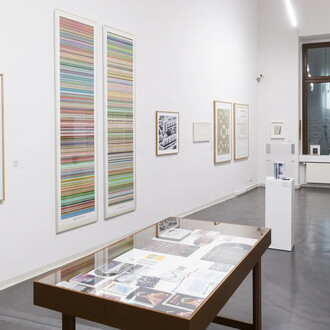As a contribution to the thirtieth anniversary of the Barbara Gross Galerie, two of the gallery’s artists have been invited to examine and interpret their own gallerist’s program. The second of three successive, retrospective exhibitions, this selection of works, curated by Ayşe Erkmen and Karin Sander from the gallery’s collection, is titled Precision & Politics. The show aims at interpreting a subjective approach to the aesthetic orientation of the gallery program.
If the first part of the exhibition series focused on Barbara Gross’s personal initiative and her curiosity, seeing the art of women as an initiation concept for the gallery, how, the current artist-curators ask, did her aspirations evolve during the gallery’s second decade? What sort of groundwork did she lay in order to argue her position?
Let’s assume that it’s a law that a succession of quite dissimilar expressions—which in this case were autonomous exhibitions—inevitably yield a context, a hidden subtext; hence, the statics of the overall experiment consists of logic and legible rules. Similar to how participants in a collectively drawn Cadavre Exquis blindly generate an entity or being that never existed before but nevertheless, as we realize, stick to the anatomically necessary intersections of the neck and legs in order to erect and to name it, the exhibition Precision & Politics undertakes an interesting attempt to unfold the intersections of the gallery with its proclivity for ambiguous works of art. And, continuing with the metaphor of joint action, the game of Cadavre Exquis is mentally passed onto the exhibition viewer and those familiar with the gallery to provide the being, which has already been given a head, torso, and other extremities, with its own ground and thereby to give it a place.
Whence do the terms for the aesthetic of the Barbara Gross Galerie come from, which was earlier sociopolitically involved in the issue of women’s rights? And what did the gallerist herself learn from her artists’ precise authoring of works? After all, the conceptual as the antithesis of the emotional and expressive united even the group of women artists in the gallery’s first decade. The terms derive from the continuum of realizing exhibitions, from the encounter working in cooperation with woman artists, and finally from the realization that the principle of precision and politics can potentially be expanded on a broad spectrum and ultimately transforms the women’s question into a question of pangender dignity. This, for the artist-curators, is as an obvious starting point to describe their gallery and to name the context that they themselves, under the auspices of Barbara Gross, also help shape.
















